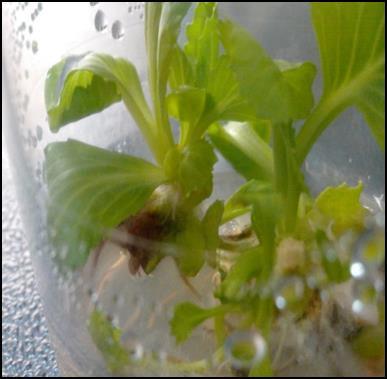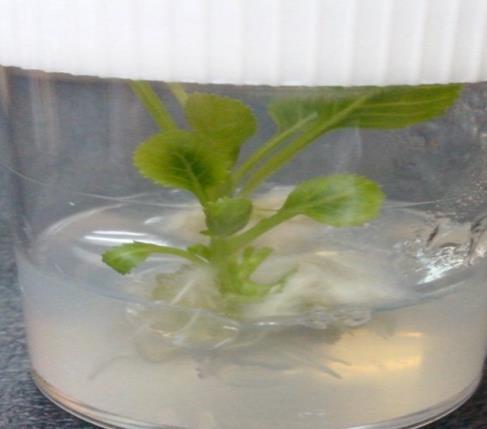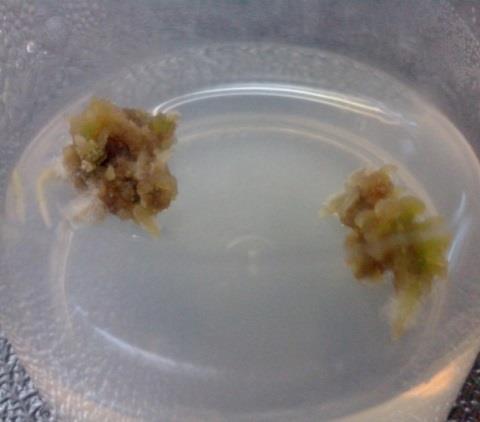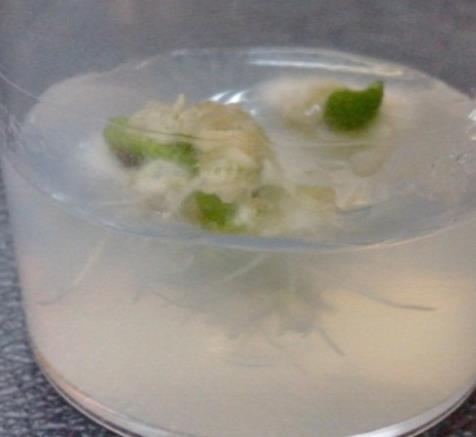ISSN 2348-1218 (print)
International Journal of Interdisciplinary Research and Innovations ISSN 2348-1226 (online) Vol. 8, Issue 4, pp: (126-131), Month: October - December 2020, Available at: www.researchpublish.com

ISSN 2348-1218 (print)
International Journal of Interdisciplinary Research and Innovations ISSN 2348-1226 (online) Vol. 8, Issue 4, pp: (126-131), Month: October - December 2020, Available at: www.researchpublish.com
Daud, N. F.1*, Hasbullah, N. A.1 , Azis, N.A.1 ,Rasad, F.M.1 , Lassim, M.M2
1Department of Agricultural Science, Faculty of Technical and Vocational, Universiti Pendidikan Sultan Idris (UPSI), 35900 Tanjung Malim, Perak, Malaysia
2Faculty of Sustainable Agriculture (Sandakan Campus), Universiti Malaysia Sabah (UMS), 90000, Sandakan, Sabah, Malaysia.
Email: fare_inmush258@yahoo.com
Abstract: Experiments were carried out to establish optimum culture condition and to identify the most responsive explants for regeneration of Brassica oleraceae L. var Capitata through plant tissue culture system. The experiment was induced by manipulating various growth regulators during organogenesis using stems, petioles, leaves and roots as explants. The experimental design of this study was Complete Randomized Design (CRD) method. For shoot regeneration using different concentrations of BAP and NAA, the most responsive explant was stem explants in which MS medium supplemented with 1.5 mg/L BAP and 0.5 mg/L NAA produced 8.400 ± 0.889 shoots per explant. Whereas, for root regeneration using different concentrations of BAP and NAA, the most responsive explant was leaf in which MS media supplemented with 0.5 mg/L BAP and 0.5 mg/L NAA produced 51.133 ± 2.929 roots per explant. This research showed that a morphogenesis study of Brassica oleraceae L. var Capitata through tissue culture system was successfully achieved. This study could lead to the better research and development (R&D) for vegetables in the future.
Keywords: morphogenesis, in vitro, Murashige and Skoog medium, callus, plantlets.
Tissue culture is one of the methods to propagate plants in a short period of time. It is also known as in vitro propagation and micropropagation. Tissue culture is one of the methods in which small part of plants (explant) whether the leaves, stems (organ) or cells were placed into the cultured medium for growth purpose in sterile or aseptic that is in the condition that free from microorganisms such as fungus, bacteria, and viruses [1]. Besides that, plant tissue culture or micropropagation means the way of rapidly multiplying plant materials stock to ensure large number of plant progeny could be produced [2] Plant tissue culture needs the medium to replace the role of soil and fertilizer. There are many types of plant tissue culture medium. The most commonly used is known as Murashige and Skoog medium (MS) [3] Brassica oleraceae L. var Capitata or commonly known as cabbage is derived from Brassica family Cabbage is an important vegetable plant; grown on large surfaces worldwide, occupying the third place in the world, after solanaceae and onion [4]. It contains high amounts of vitamin such as vitamin K, C, A and folic acid, flavonoids, fiber, proteins and mineral anticarcinogenic and glucosinolates [5]. For instance, antioxidant is rich in the cabbage can be used to treat many types of cancer. The risk of breast and colon cancer will be lowered by eating cabbage two to three times per week [6]. Due to its importance, Brassica oleraceae L. var Capitata has very high demand by consumers. The sustainability of
ISSN 2348-1218 (print)
International Journal of Interdisciplinary Research and Innovations ISSN 2348-1226 (online) Vol. 8, Issue 4, pp: (126-131), Month: October - December 2020, Available at: www.researchpublish.com
Brassica production has to be ensured. Besides propagating Brassicas through conventional methods, as an alternative, it can also be produced through plant tissue culture system. Therefore, in the present study, explants of Brassica oleraceae L. var Capitata will cultured through plant tissue culture system to obtain mass propagation of this important vegetable crop.
The seeds of Brassica oleraceae L.var capitata were obtained from commercial agricultural nursery that is nearby Sultan Idris Educational University (UPSI), Tanjong Malim, Perak. The seeds must be fully sterilized to prevent from the contamination agent such like bacteria and fungus.
MS basal medium (free hormone) was used for germination of sterilized seeds. The materials used to produce the medium were 30.00 g/L sucrose, 8.00 g/L technical agar and 4.40 g/L basal salt mixture. Then, for further micropropagation experiments, the explants culture media was enriched with various plant growth regulators and at various concentration combinations. The pH of the media was adjusted to pH 5.8 prior to autoclaving at 105 kPa and temperature at 121ºC for 20 minutes.
Sterilization of seeds is an important initial step. Firstly, the seeds were left under the running tap water for one hour. Secondly, the seeds surface were sterilized in commercial sodium hypochlorite at different concentration. The concentrations were 70 % (5 minutes), 50 % (5 minutes), 20 % (10 minutes), 10 % (10 minutes) and distilled water (10 minutes). The seeds were soaked in sodium hypochlorite and were gently agitated. Next, the seeds were transferred into the laminar air flow cabinet. After that, the seeds were dipped in 70 % of ethanol for one minutes and rinsed for about three times with sterile distilled water all over again. Lastly, the seed were dried on a sterile tissue or filter paper. The seeds that were ready to be cultured were placed into the jar containing MS (Murashige and Skoog, 1962) basal medium.
The explants used were obtained from the 4 -week-old aseptic seedlings. The part of the explants excised were stems, leaves, roots and petioles. Leaves explants were excised into small pieces of 10 mm X 10 mm in size. Roots, petioles and stems explant were cut into 10 mm in length. All the explants were cultured on MS medium supplemented with various concentration combination of hormone.
In this research, two types of hormone were used which were Naphthalene Acetic Acid (NAA) and 6-Benzylaminopurine (BAP). Both hormones function as plant growth regulators for the formation of shoots and roots. These hormones were prepared in combinations.
All data was statistically analysed. The analysis of variance (ANOVA) for the design were carried out in order to detect the significance differences among the treatments.
Table 1 showed the results of different concentrations and combinations of BAP and NAA on stem, petiole, leaf and root explants cultured on MS media for regeneration of shoot. For stem explant, mostly all stem explant gave positive respond to all combination of NAA and BAP. The best respond was cultured on MS media supplemented with 1.5 mg/L BAP + 0.5 mg/L NAA with 8.400 ± 0.899 shoots per explant (Fig. 1a). Moreover, petiole explant showed respond to only four treatments. The best respond was on MS media supplemented with 1.0 mg/L BAP + 0.5 mg/L NAA with 5.567 ± 1.070 shoots per explant (Fig. 1b). Next, the regeneration of shoot from leaf and root explant showed the lowest respond towards NAA and BAP. Only three treatments showed respond for leaf explant. MS media with 1.0 mg/L BAP + 0.5
ISSN 2348-1218 (print)
International Journal of Interdisciplinary Research and Innovations ISSN 2348-1226 (online) Vol. 8, Issue 4, pp: (126-131), Month: October - December 2020, Available at: www.researchpublish.com
mg/L NAA gave the highest shoot regeneration with 2.533 ± 0.540 (Fig. 1c). However, root explants showed respond to only two treatments only. The highest was MS media supplemented with 1.0 mg/L BAP + 0.5 mg/L NAA with 1.267 ± 0.544 shoots per explant (Fig. 1d)
In the regeneration of shoot using NAA and BAP, stem was the best explant from all four explant. This was supported by Yaacob et al. (2014) in the research of in vitro regeneration in Citrus assamensis [7]. While the least responsive explant was root because it only responded to two treatments. The optimum result of stem explant was when the explant was cultured on MS media supplemented with 1.5 mg / L BAP + 0.5 mg / L NAA.
Table 1: The Effect of Different Concentrations and Combinations of BAP and NAA on Stem, Petiole, Leaf and Root Explants Cultured on MS Media for Regeneration of Shoot at 23±1°C with 16 Hours Light and Eight Hours Dark.
Explants (Mean ± SE)
Stem Petiole Leaf Root
1 0.5 mg/L BAP + 0.5 mg/L NAA 0.000 ± 0.000f 2.333 ± 0.410c 1.733 ± 0.271c 0.000 ± 0.000b
2 1.0 mg/L BAP + 0.5 mg/L NAA 6.967 ± 1.149b 5.567 ± 1.070a 2.533 ± 0.540a 1.267 ± 0.544a
3 1.5 mg/L BAP + 0.5 mg/L NAA 8.400 ± 0.889a 0.000 ± 0.000d 0.000 ± 0.000d 0.000 ± 0.000b 4 2.0 mg/L BAP + 0.5 mg/L NAA 4.033 ± 0.809bc 3.633 ± 0.628b 2.267 ± 0.452b 0.000 ± 0.000b
5 0.5 mg/L BAP + 1.0 mg/L NAA 3.300 ± 0.766bcd 0.567 ± 0.092d 0.000 ± 0.000d 0.000 ± 0.000b 6 1.0 mg/L BAP + 1.0 mg/L NAA 3.400 ± 0.433bc 0.000 ± 0.000d 0.000 ± 0.000d 0.000 ± 0.000b 7 1.5 mg/L BAP + 1.0 mg/L NAA 4.700 ± 0.897b 0.000 ± 0.000d 0.000 ± 0.000d 0.000 ± 0.000b 8 2.0 mg/L BAP + 1.0 mg/L NAA 2.200 ± 0.399cde 0.000 ± 0.000d 0.000 ± 0.000d 0.000 ± 0.000b 9 0.5 mg/L BAP + 1.5 mg/L NAA 2.200 ± 0.550cde 0.000 ± 0.000d 0.000 ± 0.000d 0.000 ± 0.000b 10 1.0 mg/L BAP + 1.5 mg/L NAA 1.500 ± 0.287def 0.000 ± 0.000d 0.000 ± 0.000d 0.000 ± 0.000b 11 1.5 mg/L BAP + 1.5 mg/L NAA 1.433 ± 0.257def 0.000 ± 0.000d 0.000 ± 0.000d 0.000 ± 0.000b 12 2.0 mg/L BAP + 1.5 mg/L NAA 0.000 ± .000f 0.000 ± 0.000d 0.000 ± 0.000d 0.000 ± 0.000b 13 0.5 mg/L BAP + 2.0 mg/L NAA 0.000 ± 0.000f 0.000 ± 0.000d 0.000 ± 0.000d 0.000 ± 0.000b 14 1.0 mg/L BAP + 2.0 mg/L NAA 2.400 ± 0.518cde 0.000 ± 0.000d 0.000 ± 0.000d 0.000 ± 0.000b 15 1.5 mg/L BAP + 2.0 mg/L NAA 3.467 ± 0.602bc 0.000 ± 0.000d 0.000 ± 0.000d 0.000 ± 0.000b 16 2.0 mg/L BAP + 2.0 mg/L NAA 0.867 ± 0.234ef 0.000 ± 0.000d 0.000 ± 0.000d 0.000 ± 0.000b 17 0.0 mg/L BAP + 0.0 mg/L NAA 2.800 ± 0.574cd 0.000 ± 0.000d 0.800 ± 0.297c 0.233 ± 0.092b
Mean ± SE, n=30. Mean with Different Letters in the Same Column Differ Significantly at p=0.05
ISSN 2348-1218 (print)
International Journal of Interdisciplinary Research and Innovations ISSN 2348-1226 (online) Vol. 8, Issue 4, pp: (126-131), Month: October - December 2020, Available at: www.researchpublish.com
(a)
0.4 cm 0.4 cm 0.4 cm 0.4 cm
(b) (c) (d)
Fig. 1. Identification of Shoot Regeneration Media of Brassica oleraceae L. var Capitata. (a) Regeneration of shoot from stem explant cultured on MS media supplemented with 1.0 mg/L BAP + 0.5 mg/L NAA; (b) Regeneration of shoot from petiole explant cultured on MS media supplemented with 1.0 mg/L BAP + 0.5 mg/L NAA; (c) Regeneration of shoot from leaf explant cultured on MS Media supplemented with 1.0 mg/L BAP + 0.5 mg/L NAA; (d) Regeneration of shoot from root explant cultured on MS media supplemented with 1.0 mg/L BAP + 0.5 mg/L




Response and development of rooting of Brassica oleraceae L.var Capitata explant when subcultured on root induction media with different concentration and combination of BAP and NAA is shown in Table 2 For stem explant, the best respond was MS media with 1.0 mg/L BAP + 0.5 mg/L NAA with 30.167 ± 2.769roots per explant (Fig. 2a). Meanwhile, petiole explant showed the highest respond MS media supplemented with 0.5 mg/L BAP + 0.5 mg/L NAA with 29.800 ± 1.783roots per explant (Fig. 2b). Leaf explant showed best respond for regeneration of root on MS media added with 0.5 mg/L BAP + 0.5 mg/L NAA with 51.133 ± 2.929roots per explant (Fig. 2c). Besides, root explant gave optimum respond when MS media supplemented with 0.5 mg/L BAP + 1.0 mg/L NAA with 23.500 ± 1.049roots per explant (Fig. 2d).
Regeneration of root on NAA and BAP showed that all four types of explants were responsive. However, the highest respond was on leaf explant when cultured in the combination treatment of 0.5 mg/L BAP + 0.5 mg/L NAA. This was line with Hussein (2012) that stated that auxin such as Naphtalene acetic acid (NAA) have been reported to promote plant rooting in vitro culture condition [8]. In addition, the use of BAP was also agreed by Ngomuo, Mneney and Ndakidemi (2013) stating that N6-benzylaminopurine (BAP) is the most commonly preferred cytokinin on growth and development [9].
ISSN 2348-1218 (print)
International Journal of Interdisciplinary Research and Innovations ISSN 2348-1226 (online) Vol. 8, Issue 4, pp: (126-131), Month: October - December 2020, Available at: www.researchpublish.com
Table 2: The Effect of Different Concentrations and Combinations of BAP and NAA on Stem, Petiole, Leaf and Root Explants Cultured on MS Media for Regeneration of Root at 23±1°C with 16 Hours Light and Eight Hours Dark.
No Treatments
Explants (Mean ± SE) Stem Petiole Leaf Root

1 0.5 mg/L BAP + 0.5 mg/L NAA 9.333 ± 0.828cde 29.800 ± 1.783a 51.133 ± 2.929a 15.933 ± 1.208bc
2 1.0 mg/L BAP + 0.5 mg/L NAA 30.167 ± 2.769a 25.267 ± 2.744b 36.100 ± 2.944b 21.967 ± 2.091b

3 1.5 mg/L BAP + 0.5 mg/L NAA 13.067 ± 1.262bcd 1.000 ± 0.311gh 0.000 ± 0.000g 0.000 ± 0.000h
4 2.0 mg/L BAP + 0.5 mg/L NAA 2.200 ± 0.466gh 9.667 ± 1.387de 7.700 ± 0.738ef 2.267 ± 0.518gh
5 0.5 mg/L BAP + 1.0 mg/L NAA 11.233 ± 4.181cde 29.267 ± 3.913b 10.500 ± 3.064de 23.500 ± 1.049a
6 1.0 mg/L BAP + 1.0 mg/L NAA 17.467 ± 1.817b 0.000 ± 0.000h 18.033 ± 2.643c 17.033 ± 1.863b
7 1.5 mg/L BAP + 1.0 mg/L NAA 11.300 ± 0.934cde 11.167 ± 0.685cd 3.067 ± 0.711fg 5.500 ± 0.352f
8 2.0 mg/L BAP + 1.0 mg/L NAA 17.167 ± 1.527b 8.433 ± 1.276def 3.033 ± 0.905fg 9.900 ± 1.034de
9 0.5 mg/L BAP + 1.5 mg/L NAA 8.500 ± 1.494def 15.233 ± 1.236c 7.967 ± 1.228def 7.033 ± 0.962ef 10 1.0 mg/L BAP + 1.5 mg/L NAA 14.700 ± 1.127bc 12.833 ± 1.233cd 9.933 ± 1.719de 6.567 ± 0.926f
11 1.5 mg/L BAP + 1.5 mg/L NAA 6.067 ± 0.975efg 3.433 ± 0.891fgh 0.000 ± 0.000g 0.000 ± 0.000h
13 0.5 mg/L BAP + 2.0 mg/L NAA 0.000 ± 0.000h 8.133 ± 1.762def 0.000 ± 0.000g 14.300 ± 1.149bc 14 1.0 mg/L BAP + 2.0 mg/L NAA 9.500 ± 1.402cde 22.900 ± 1.479b 8.500 ± 1.341de 13.767 ± 1.125c 15 1.5 mg/L BAP + 2.0 mg/L NAA 13.633 ± 1.686bcd 11.433 ± 1.146cd 13.167 ± 1.063d 10.800 ± 1.183d 16 2.0 mg/L BAP + 2.0 mg/L NAA 6.667 ± 1.453efg 5.633 ± 1.362efg 12.200 ± 1.821de 17.300 ± 1.176b 17 0.0 mg/L BAP + 0.0 mg/L NAA 6.700 ± 1.336efg 1.267 ± 0.166gh 1.300 ± 0.329g 4.767 ± 0.243fg
Mean ± SE, n=30. Mean with Different Letters in the Same Column Differ Significantly at p=0.05 (a) (b) (c) (d)
Fig. 2. Identification of Root Regeneration Media of Brassica oleraceae L. var Capitata. (a) Regeneration of root from stem explant cultured on MS Media supplemented with MS 1.0 mg/L BAP + 0.5 mg/L IAA; (b) Regeneration of root from petiole explant cultured on MS Media supplemented with 0.5 mg/L BAP + 0.5 mg/L NA; (c) Regeneration of root from leaf explant cultured on MS media supplemented with 0.5 mg/L BAP + 0.5 mg/L NAA; (d) Regeneration of root from root explant cultured on MS media supplemented with 0.5 mg/L BAP + 1.0 mg/L NAA


ISSN 2348-1218 (print)
International Journal of Interdisciplinary Research and Innovations ISSN 2348-1226 (online) Vol. 8, Issue 4, pp: (126-131), Month: October - December 2020, Available at: www.researchpublish.com
As a conclusion, morphogenesis studies of Brassica oleraceae L. var Capitata through tissue culture system were successfully achieved. Studies on Brassica oleraceae L. var Capitata needs to be expanded as the number of studies is still limited. Therefore, this study provide information and knowledge on micropropagation of Brassica oleraceae L. var Capitata. This research is hoped to be able to contribute and benefit the agricultural industry in worldwide.
The authors would like to thank Sultan Idris Education University (UPSI) and Research Management and Innovation Centre (RMIC) of UPSI for providing University Research Grant (GPU), project code : 2015-0056-102-01 and the facilities to carry out this research. The authors would also like to thank Faculty of Technical and Vocational (FTV) of UPSI for the technical assistance and facilities provided throughout the research.
[1] Rosna M.T. (2004). Kultur Tisu Tumbuhan Berbunga : Penerbit Universiti Malaya, pp : 23
[2] Touchell, D., Smith, J. and Ranney, T. G. (2008). Novel Applications of Plant Tissue Culture : North Carolina State University, North Carolina, pp : 22-23
[3] Murashige, T. & Skoog, F. A (1962). Revised Medium for Rapid Growth and Bio Assays with Tobacco Tissue Cultures. Physiologia Plantarum. 15,pp: 473-497.
[4] Cristea, T. O. (2013). The Influence of pH on Microspore Embryogenesis of White Cabbage (Brassica oleraceae L.). Not Sci Biol, 5 (4) : 485-489.
[5] Yussof, A. I. M., Wafa, S. N. & Taha, R. M. (2012). Plant regeneration and synthetic seeds production of Brassica oleraceae var. italic. International Symposium on Sustainable Vegetable Production in Southeast Asia. doi: 10.17660/ActaHortic.2012.958.21
[6] Chooi, H. O. (2008). Vegetables for Health & Healing. Kuala Lumpur: Utusan Publications and Distributors Sdn. Bhd, pp: 58-59.
[7] Yaacob, J.S., Mahmud,N., Taha, R.M., Mohamed, N., Yussof, A.I.M., & Saleh, A. (2014). Optimization of culture conditions (sucrose, pH, and photoperiod) for in vitro regeneration and early detection of somaclonal variation in ginger lime (citrus assamensis). The Scientific World Journal, articles ID 262710.
[8] Hussein, N. (2012). Effects of Nutrient Media Constituents on Growth and Development of Banana (Musa spp.) Shoot Tips Cultured in Vitro. African Journal of Biotechnology. 11(37), pp. 9001-9006
[9] Ikeuchi, M., Sugimoto, K. & Iwase, A. (2013). Plant Callus : Mechanisms of Induction and Repression. The Plant Cell, 25(9), 3159-3173. https://doi: 10.1105/tpc. 113.116053